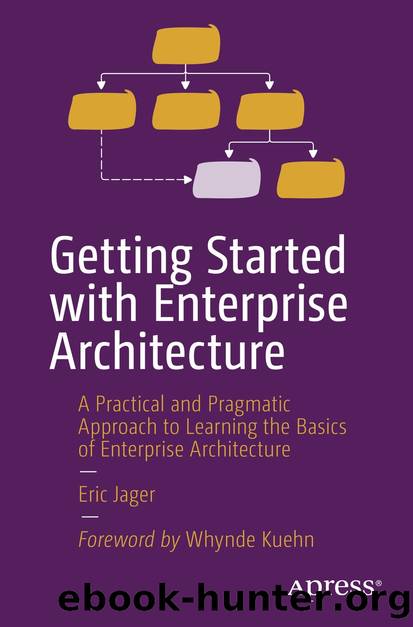Getting Started with Enterprise Architecture by Eric Jager

Author:Eric Jager
Language: eng
Format: epub
ISBN: 9781484298589
Publisher: Apress
8.2.2 Stakeholders
The stakeholder concept is fundamental to representing an individual, group, or organization that has an interest in the outcome of an architecture effort. Stakeholders are critical to the success of any Enterprise Architecture initiative because they provide input, have concerns, and influence decision-making throughout the architecture development process. Enterprise Architects use the stakeholder concept to identify and analyze the concerns and interests of various stakeholders. Understanding stakeholder needs and expectations helps define architecture requirements and ensures that the architecture effectively addresses business goals.
Stakeholders are actively involved throughout the architecture development process. Enterprise Architects work with stakeholders to gather information, obtain feedback, and validate architectural decisions. Effective stakeholder engagement results in a shared understanding of business goals and ensures buy-in for the proposed architecture.
The stakeholder concept facilitates effective communication with various groups within the organization. Architects use the concept to document stakeholder relationships, communication channels, and key roles within the architecture effort. It helps manage expectations and ensure that stakeholders are kept informed of progress and results.
Stakeholders play a critical role in assessing the impact of architecture decisions on various business areas. By understanding stakeholder perspectives, architects can identify potential risks and opportunities associated with architectural changes and align the architecture with the organizationâs strategy. The primary goal of Enterprise Architecture is to align IT with business goals. Understanding stakeholder perspectives helps architects prioritize initiatives and allocate resources to projects that deliver the most value to the organization and its stakeholders.
Stakeholders are an important source of requirements for the architecture. By interacting with stakeholders, architects can elicit and document their needs, which become the basis for developing architectural models and solutions. The stakeholder concept helps architects make informed decisions. By considering the interests and concerns of different stakeholders, architects can balance conflicting requirements and ensure that architectural decisions are well accepted and aligned with business priorities.
The stakeholder concept is closely related to governance in Enterprise Architecture. By understanding who the stakeholders are and what their interests are, architects can establish governance mechanisms to address their concerns, maintain transparency, and ensure accountability.
Being able to communicate properly with stakeholders â the key players within the organization â is essential. To identify these key players in an organization, stakeholder management can be applied. Stakeholder management is the process of identifying and understanding the needs, interests, and expectations of an organizationâs various stakeholders, and planning and implementing actions to address those interests and improve cooperation and communication with them.
In the context of the TOGAF Standard, stakeholder management is an essential part of Enterprise Architecture development and is explicitly reflected in what the framework calls the Architecture Development Cycle4. Stakeholder management is one of the most important factors in the success of an Enterprise Architecture initiative.Table 8-20 Deliverables of stage one â Document/Stakeholders
Download
This site does not store any files on its server. We only index and link to content provided by other sites. Please contact the content providers to delete copyright contents if any and email us, we'll remove relevant links or contents immediately.
Hit Refresh by Satya Nadella(9083)
The Compound Effect by Darren Hardy(8872)
Change Your Questions, Change Your Life by Marilee Adams(7686)
Nudge - Improving Decisions about Health, Wealth, and Happiness by Thaler Sunstein(7659)
The Black Swan by Nassim Nicholas Taleb(7058)
Deep Work by Cal Newport(6966)
Rich Dad Poor Dad by Robert T. Kiyosaki(6514)
Daring Greatly by Brene Brown(6474)
Principles: Life and Work by Ray Dalio(6296)
Playing to Win_ How Strategy Really Works by A.G. Lafley & Roger L. Martin(6084)
Man-made Catastrophes and Risk Information Concealment by Dmitry Chernov & Didier Sornette(5957)
Digital Minimalism by Cal Newport;(5704)
Big Magic: Creative Living Beyond Fear by Elizabeth Gilbert(5679)
The Myth of the Strong Leader by Archie Brown(5458)
The Slight Edge by Jeff Olson(5376)
Discipline Equals Freedom by Jocko Willink(5336)
The Motivation Myth by Jeff Haden(5175)
The Laws of Human Nature by Robert Greene(5081)
Stone's Rules by Roger Stone(5052)
